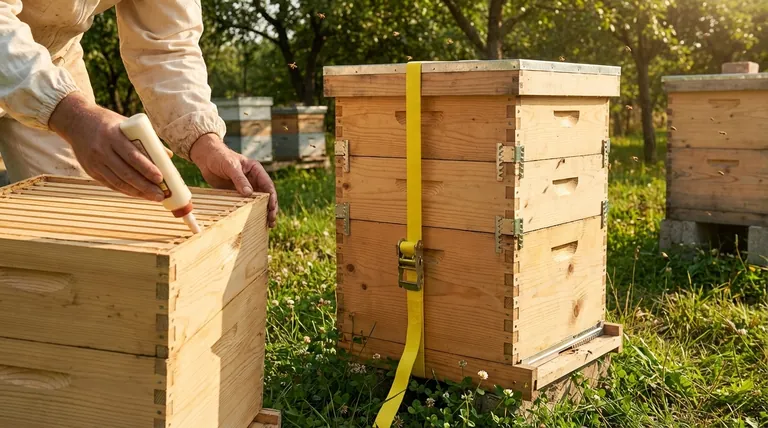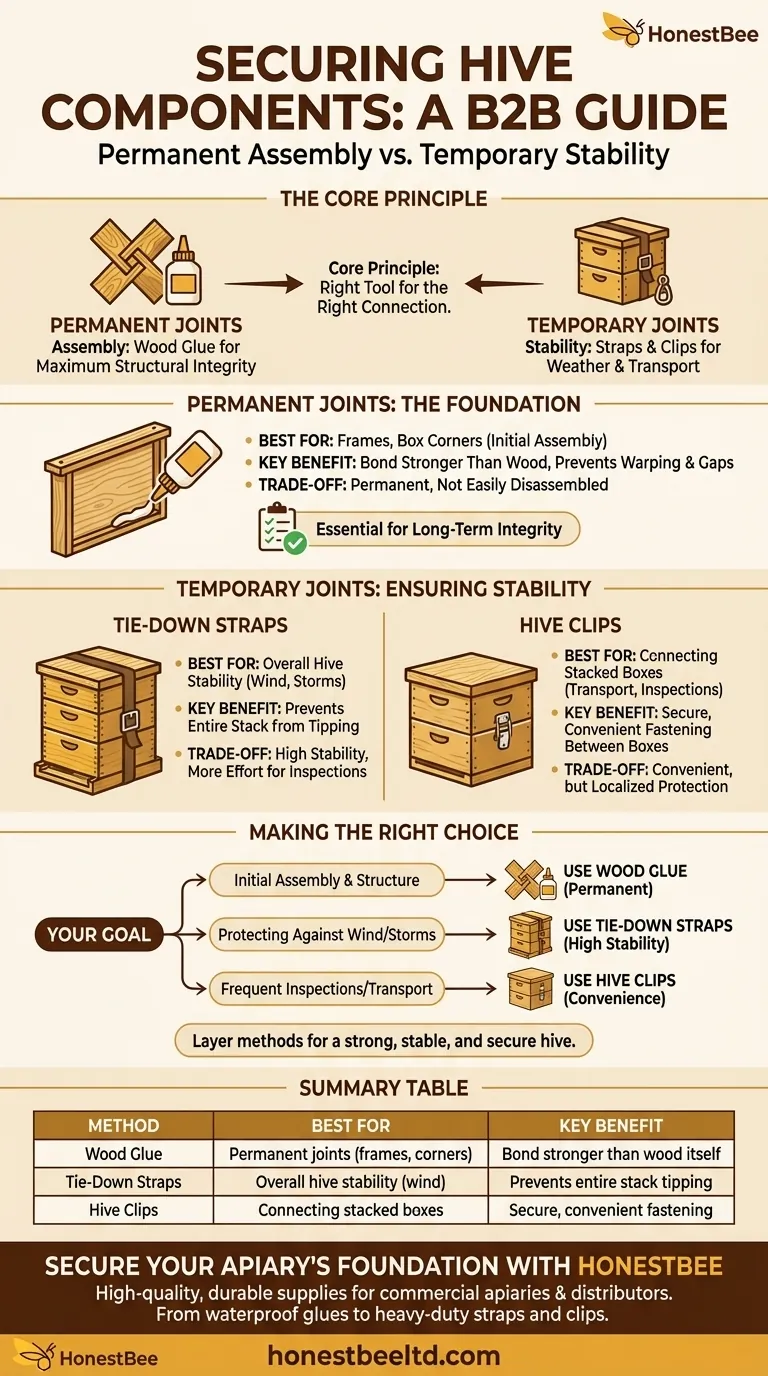For securing beehive components, a two-part approach is recommended. Permanent joints, such as those in frames and box corners, should be assembled with wood glue for maximum structural integrity. For temporarily connecting stacked hive bodies and securing the entire hive, methods like tie-down straps or specialized hive clips are used to ensure stability against weather and during transport.
The core principle of hive security is using the right tool for the right connection. Wood glue creates permanent strength for individual components, while straps and clips provide the necessary temporary stability for the assembled hive stack.

Securing Permanent Joints: The Role of Assembly
The initial construction of your hive components sets the foundation for their entire service life. Ensuring these joints are strong from the start is non-negotiable.
Why Wood Glue is Essential
For assembling components like frames and the finger joints of hive boxes, wood glue is the standard. It creates a bond that is often stronger than the wood itself, preventing separation and maintaining the precise geometry of the component.
The Benefit of Lasting Integrity
A well-glued joint resists warping and stress. This ensures frames fit correctly and boxes stack flush, minimizing gaps that could allow pests or drafts to enter the hive.
Securing Stacked Components: Ensuring Stability
Once assembled, the individual hive boxes must be secured to each other and to their stand to protect the colony from external forces.
The Function of Tie-Down Straps
A tie-down strap is the primary tool for preventing an entire hive from tipping over. It is typically wrapped vertically around the whole hive stack, from the lid to the bottom board or hive stand.
This method is crucial for protecting the colony from being lost or damaged during high winds, blustery storms, or accidental bumps.
The Role of Hive Clips and Buckles
Hive clips or buckles are specialized fasteners that connect individual hive boxes to one another. They ensure a tight, secure fit between each component in the stack.
This prevents parts from shifting or becoming detached, which is critical for maintaining hive integrity during transportation or in adverse weather. A secure stack minimizes exposure points for predators or the elements.
Understanding the Trade-offs
Each securing method serves a distinct purpose and comes with its own set of considerations. Understanding these is key to proper hive management.
Glue: Permanent and Powerful
The primary advantage of wood glue is its strength and permanence. The main trade-off is that the joint cannot be easily disassembled, which is ideal for frames but should be considered carefully for other applications.
Straps: High Stability, More Effort
Tie-down straps provide the best overall stability against tipping forces. However, they must be completely removed and re-fastened during every hive inspection, which can be slightly more time-consuming.
Clips: Convenient but Localized
Hive clips offer excellent convenience, as they are easy to release for inspecting a specific box. Their limitation is that they only secure the direct connection between two boxes and offer less protection against the entire hive tipping over compared to a full strap.
Making the Right Choice for Your Goal
Your strategy should adapt to the specific task at hand, from initial construction to long-term placement.
- If your primary focus is initial assembly: Use a quality waterproof wood glue on all frame and box joints to guarantee long-term structural integrity.
- If your primary focus is protecting the hive in a windy location: Use a heavy-duty tie-down strap wrapped vertically around the entire hive.
- If your primary focus is convenience for frequent inspections or transport: Use hive clips to securely fasten the boxes together while allowing for easy access.
By layering these methods correctly, you ensure your hive is strong, stable, and secure against any challenge.
Summary Table:
| Method | Best For | Key Benefit |
|---|---|---|
| Wood Glue | Permanent joints (frames, box corners) | Creates a bond stronger than the wood itself |
| Tie-Down Straps | Overall hive stability (wind, storms) | Prevents the entire hive stack from tipping over |
| Hive Clips | Connecting stacked boxes (transport, inspections) | Provides secure, convenient fastening between boxes |
Secure Your Apiary's Foundation with HONESTBEE
Building and maintaining secure hives is fundamental to successful beekeeping. The right equipment ensures your colonies are protected from the elements and remain structurally sound season after season.
At HONESTBEE, we supply commercial apiaries and beekeeping equipment distributors with the high-quality, durable supplies needed for this critical task. From waterproof wood glues for permanent assembly to heavy-duty straps and reliable hive clips for stability, our wholesale-focused operations provide the tools for a secure and productive operation.
Let us help you build a stronger apiary. Contact our team today to discuss your commercial beekeeping supply needs.
Visual Guide

Related Products
- Professional Galvanized Hive Strap with Secure Locking Buckle for Beekeeping
- Professional Engraved Round Hive Number Tags for Beekeeping
- Professional Insulated Winter Hive Wrap for Beekeeping
- Wholesales Dadant Size Wooden Bee Hives for Beekeeping
- Black Plastic Beetle Barn Hive Beetle Trap for Beehives
People Also Ask
- What is the advantage of using cam buckle straps? Secure Your Load Fast with Simple, Safe Tensioning
- What are the types of Emlocks available? Choose the Right Strap for Hive Security
- How can beekeepers secure the top cover of a hive? Protect Your Colony from Wind and Weather
- What are the two styles of hive straps? Choose the Right Strap for Your Hive Security
- What maintenance is required for hive straps? A Guide to Cam Buckle vs. Ratchet Strap Care



















